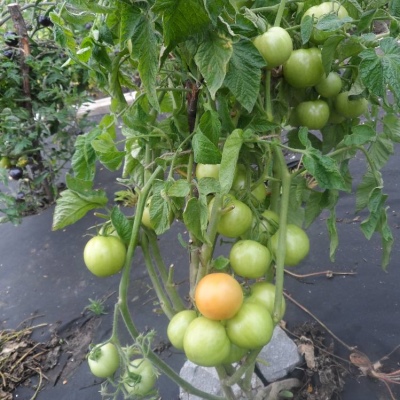
- Authors: Kulchitsky M.G., Novorossiysk
- Name synonyms: Unikalniy Kulchickogo
- Category: grade
- Growth type: indeterminate
- Appointment: universal
- Ripening period: early
- Growing conditions: for open ground, for greenhouses
- Marketability: high
- Bush size: tall
- Bush height, cm: up to 180
The tomato variety known as Unique Kulchitskiy was bred back in 1980, and since then has gained immense popularity among many gardeners. The variety is resistant to unfavorable climates. Now it is one of the most popular types of tomato in the whole country. So, according to gardeners' reviews, this variety is stable and retains a high yield even under unfavorable conditions.
Description of the variety
The plant is a tall shrub that can grow up to 1.8 meters over the entire season. The variety is grown both in the greenhouse and in the open field. As soon as the bush reaches the desired height, it must be tied to a solid support. On average, the bush gives up to 12 ovaries.
The main qualities of the fruit
Almost all tomatoes are the same size and round. Ripe fruits are dense and smooth. They are ideal for canned storage.
Taste characteristics
Ripe tomatoes have a pleasant and juicy tomato flavor, retaining these qualities even after a long time. Chopped tomatoes are suitable for various dressings and sauces. Tomatoes are also a good addition to summer salads.
Ripening and fruiting
The fruiting period is extended, but the bush bears the first fruits already 3.5 months after the sowing of the seeds has passed. The plant begins to bloom quickly, producing abundant fresh tomatoes throughout the summer.
Yield
On average, the yield of each bush reaches 5-6 kilograms. In order to increase the number of ripe fruits, you need to form three stems from the whole plant, and then tie them to the trellises. One square meter accommodates up to four bushes.
The timing of planting seedlings and planting in the ground
Sowing of seeds usually takes place 60 days before planting for seedlings. It is enough to buy one batch of seeds to be enough for the rest of the time. Seed fruits are best left in the best places and only harvested after full ripening. Experienced gardeners are advised to treat the seeds with a solution of potassium permanganate before sowing.

Growing tomato seedlings is an extremely important process, because it largely depends on whether the gardener will be able to harvest at all. All aspects must be taken into account, from seedbed preparation to planting in the ground.
Landing scheme
It should be planted in the garden according to the 40x70 centimeters scheme, and the seedlings themselves are best placed in small holes up to 20 centimeters deep. Up to 5 upper leaves should remain above the soil itself. Soon, new roots should grow from the stalks, which will feed the bush with everything it needs.

Growing and care
To get an early harvest, you need to sow seedlings in the spring, in the first days of April. If the plant grows in a greenhouse, then you need to sow seeds not earlier than February. The most optimal temperature for growing tomatoes of this variety is 20-25 ° C.
Tomatoes should be watered abundantly, but not often. Close attention to this issue should be emphasized during the period when the ovary begins to form. You need to carefully monitor the top layer of the soil. In no case should it be allowed to dry out. In addition, it is important that the soil is not too wet, as there is a good chance that the roots will rot.
The soil for planting is prepared equally from garden soil, humus and sand. Chalk or dolomite flour is kneaded into the loosened mixture. The finished substrate is poured into a sowing container, after which it is thoroughly impregnated with a solution of potassium permanganate.
The unique Kulchitsky does not differ in demanding soil, but it grows best in fertilized areas with good air permeability. Don't use organic fertilizers too often. The bush does not require regular feeding throughout the season, but mineral fertilizers are ideal for it. Most of all, the plant needs magnesium in top dressing, especially during the period of fruit ripening.
The bushes must be tied to trellises or to any other additional support. To accelerate ripening and achieve the most marketable and beautiful fruit, the plant needs careful formation.
Since the variety is not hybrid, gardeners can continue to harvest seed for later use. The unique Kulchitsky is well suited both for growing in private gardens and on farms.




A plant needs different micronutrients at each stage of growth. All fertilizers can be divided into two groups: mineral and organic. Folk remedies are often used: iodine, yeast, bird droppings, eggshells.
It is important to observe the rate and period of feeding. This also applies to folk remedies and organic fertilizers.
Disease and pest resistance
The unique Kulchitskiy is distinguished by its high resistance to diseases typical for tomatoes. As for pests, he is not immune from their threat. To prevent this, you need to provide the plant with timely care.The bush must be watered, fertilized with mineral fertilizers and regularly pinned. If these conditions are met, the tomato will be reliably protected from pests and diseases.



























































































